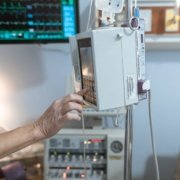Ketamine Research Studies: Top 3 Breakthroughs in 2025
Ketamine research studies have sparked widespread interest in recent years due to their potential to offer rapid relief for individuals with treatment-resistant depression. These studies have pointed to ketamine as a promising alternative, particularly for those who have not found success with traditional antidepressants.
- Relief for treatment-resistant depression: Patients with this severe form of depression often see improvements where other treatments fail.
- Rapid effects: Unlike typical antidepressants that can take weeks, many patients experience benefits within hours of ketamine therapy.
- Innovative forms: From intravenous infusions to nasal sprays, ketamine’s versatility in administration is a key topic of study.
- Ongoing research: Understanding of ketamine’s mechanisms and long-term effects is still evolving.
Treatment-resistant depression affects millions and can lead to hopelessness, much like Michelle, who described it as feeling “extremely hopeless and just empty” after years of cycling through ineffective treatments. For many like her, ketamine therapy offers a glimmer of hope and has changed the landscape of mental health treatment.
These studies dig into everything from how ketamine works at a neurological level to comparing different delivery methods. As researchers continue to open up the “ketamine code,” the focus remains on optimizing its efficacy and safety.

The Evolution of Ketamine in Depression Treatment
The journey of ketamine from an anesthetic to a potential breakthrough in treating depression is a fascinating story. Treatment-resistant depression (TRD) affects nearly 3 million people in the United States alone. For decades, these individuals have struggled to find relief from conventional antidepressants, which often take weeks to show effects and sometimes don’t work at all.
NIMH Research and the Role of Ketamine
The National Institute of Mental Health (NIMH) has been at the forefront of research into ketamine’s potential as an antidepressant. In the early 2000s, researchers like Carlos Zarate, M.D., began exploring ketamine as a treatment for TRD. Despite its origins as an anesthetic, ketamine showed promise in providing rapid relief from depressive symptoms, a stark contrast to traditional monoaminergic antidepressants.
The groundbreaking research supported by the NIMH has highlighted ketamine’s potential, offering a new option for those who had exhausted other treatments.
A New Hope for Patients
For patients like Michelle, who endured years of ineffective treatments, ketamine therapy has been transformative. Michelle’s experience with TRD, marked by a profound sense of hopelessness, is not uncommon. Many patients describe the condition as an endless cycle of trying new medications, only to face disappointment when they don’t work. Ketamine has broken this cycle for many, offering a new pathway to relief.

Continued Research and Future Directions
While the exploration of ketamine’s potential has been a significant step, research is ongoing. Scientists are keen to understand how ketamine works at a neurological level, particularly its interaction with the NMDA receptor and the glutamate system. These studies aim to optimize treatment protocols and ensure safety, paving the way for even more effective therapies in the future.
The evolution of ketamine in depression treatment is a testament to the power of innovative research and the relentless pursuit of solutions for those in need. As we continue to learn more, the hope is to refine these therapies and extend their benefits to as many people as possible.
Ketamine Research Studies: Current Landscape
The use of ketamine in treating depression has gained momentum, propelled by promising clinical trials and real-world applications. These studies focus on understanding how ketamine can help those with treatment-resistant depression (TRD), who often find little relief from traditional antidepressants.
Key Findings from Recent Studies
One of the most notable studies is the Bio-K study, which explored the effects of ketamine on individuals with severe depression or bipolar disorder. This study involved 74 participants across clinics in Michigan, Maryland, and Minnesota. After just three ketamine infusions over 11 days, an impressive 52% of participants experienced remission from severe depression. Moreover, 50% of those with frequent suicidal thoughts saw a significant reduction in those impulses.

These findings underscore ketamine’s potential as a rapid-acting antidepressant, providing hope for those who have not responded to other treatments.
Comparing Delivery Methods: IV vs Nasal Spray
When it comes to administering ketamine, two primary methods are used: IV infusions and nasal spray.
IV Ketamine: This method involves delivering ketamine directly into the bloodstream, allowing for precise control of dosage and rapid onset of effects. Patients typically undergo a series of six infusions over two to three weeks. The quick relief offered by IV ketamine makes it an appealing option for those needing immediate improvement in mood.
Nasal Spray: This form of ketamine provides a more convenient and less invasive alternative to IV infusions. Patients self-administer the spray under medical supervision, which is often combined with oral antidepressants. This method is particularly beneficial for those uncomfortable with needles or seeking a more user-friendly option.
Patient Outcomes
Both IV ketamine and nasal spray have shown positive outcomes in reducing depressive symptoms. However, each method has its unique advantages. IV infusions offer rapid relief and precise dosing, while nasal spray provides ease of use and accessibility. The choice between these methods often depends on patient preference, severity of symptoms, and accessibility to treatment facilities.
The landscape of ketamine research studies continues to evolve, providing valuable insights into the most effective ways to use this treatment. As research advances, the goal is to refine these delivery methods and extend relief to more patients suffering from depression.
In the next section, we will dig into the mechanisms behind ketamine’s antidepressant effects, exploring how it interacts with the brain’s NMDA receptors and glutamate systems.
Understanding the Mechanisms: How Ketamine Works
Ketamine’s effectiveness in treating depression largely hinges on its interaction with the NMDA receptor and the broader glutamate systems in the brain. These interactions are key to its rapid antidepressant effects, especially for those with treatment-resistant depression.
NMDA Receptor and Glutamate Systems
The NMDA receptor is part of the brain’s glutamate system, which plays a crucial role in mood and cognition. Ketamine acts as a non-competitive antagonist to these receptors, blocking their activity. This blockade results in an increase in glutamate levels, activating another type of receptor known as AMPA receptors. This activation is essential for enhancing synaptic plasticity—the brain’s ability to form new, stronger connections.
By promoting synaptic plasticity, ketamine can “reset” the brain’s pathways, which is particularly beneficial for individuals with depression. These new pathways can disrupt old, harmful patterns that contribute to depressive symptoms.
Antidepressant Effects
Ketamine’s ability to quickly alleviate depressive symptoms is partly due to its impact on synaptic plasticity. Unlike traditional antidepressants, which can take weeks to show effects, ketamine can provide relief within hours. This rapid action is a lifeline for those with severe symptoms, offering a much-needed respite.
Potential Biomarkers for Predicting Success
Researchers are exploring blood biomarkers, cell signaling proteins, and inflammatory markers to predict who might benefit most from ketamine treatment. Identifying these biomarkers could help tailor treatments to individual patients, improving outcomes and reducing trial-and-error in finding effective therapies.
Blood biomarkers can provide insights into how a patient’s body responds to ketamine. Certain proteins and markers in the blood might indicate a higher likelihood of positive response, guiding clinicians in treatment planning.
Cell signaling proteins play a role in how cells communicate and respond to treatments. By understanding these pathways, researchers can better predict how ketamine will affect individual patients.
Inflammatory markers are also being studied, as inflammation is often linked to depression. By monitoring these markers, researchers hope to understand how ketamine reduces inflammation and improves mood.
These insights into ketamine’s mechanisms and potential biomarkers are paving the way for more personalized and effective treatment strategies. As we continue to explore these areas, the hope is to improve the benefits of ketamine therapy for those who need it most.
In the next section, we will address frequently asked questions about ketamine research studies, including treatment frequency, potential risks, and considerations for use during pregnancy.
Frequently Asked Questions about Ketamine Research Studies
How many ketamine treatments are needed for depression?
The number of ketamine treatments needed can vary from person to person. Typically, patients start with a series of six infusions over two to three weeks. This initial phase is aimed at quickly reducing symptoms of depression. After these sessions, maintenance treatments might be scheduled less frequently, depending on the patient’s response and remission rates.
Some patients experience relief after just one session, while others may require the full series to see significant improvement. The Bio-K study found that two-thirds of patients who responded after one infusion went on to achieve remission with further treatments.
Are there risks associated with ketamine use?
Yes, there are some risks associated with ketamine use. During treatment, patients might experience dissociation, a feeling of being detached from reality. This can be unsettling but is generally temporary and closely monitored by healthcare professionals.
Other common side effects include increased blood pressure, nausea, dizziness, and mild sedation. These effects typically subside shortly after the session.
Long-term safety data is still being gathered, and while ketamine can be effective, its use must be carefully managed. Clinics offering ketamine therapy adhere to strict safety protocols to ensure patient safety.
Can ketamine be used during pregnancy?
The use of ketamine during pregnancy is not well-studied, and there are potential risks. The effects of ketamine on fetal development are not fully understood, and it could pose a risk to the unborn child.
Due to these uncertainties, ketamine is generally not recommended for pregnant individuals. If you are pregnant or planning to become pregnant, it is crucial to discuss all treatment options and potential risks with your healthcare provider.
Understanding these aspects of ketamine research studies helps patients and healthcare providers make informed decisions about treatment options.
Conclusion
As we continue to explore the potential of ketamine in treating depression, the future looks promising. Ongoing research is crucial in understanding how ketamine can be used safely and effectively. The Bio-K study and others like it are shedding light on how ketamine can bring hope to patients who have struggled with traditional treatments.
For those interested in exploring ketamine’s potential, our platform, Buy Ketamine Crystals Online, offers a variety of ketamine products, including crystals, powder, pills, and vials. We pride ourselves on providing discreet delivery across the United Kingdom, USA, Germany, Austria, and other locations. Our unique selling point is offering ketamine without a prescription, making it more accessible for those seeking alternative treatments.
While ketamine’s role in mental health treatment is still being defined, the evidence so far suggests it can offer relief for many. Patients who have been through the endless cycle of medications and therapies without success can find new hope in ketamine research studies. The journey is just beginning, and with continued research and innovation, ketamine could soon become a cornerstone in the treatment of depression.
The road ahead is filled with possibilities, and we are committed to staying at the forefront of these developments. As research evolves, so will our offerings, ensuring that patients and healthcare providers have access to the latest and most effective treatment options.











